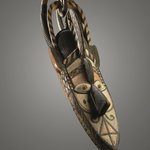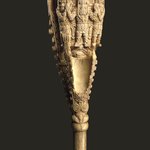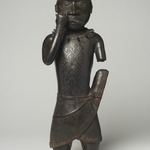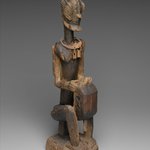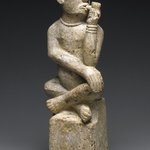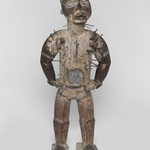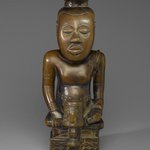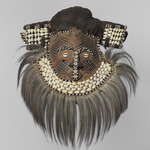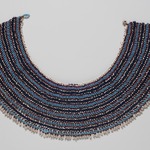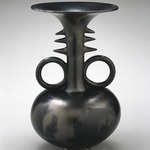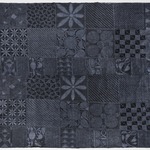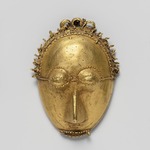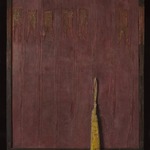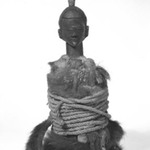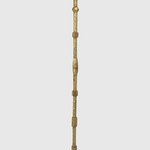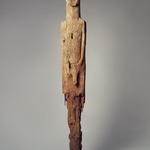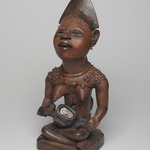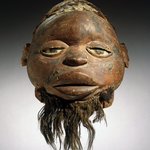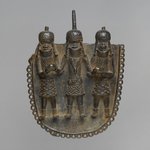Collection: Arts of Africa
HIGHLIGHTS
FULL COLLECTION
COLLECTION HISTORY
The Brooklyn Museum was one of the first museums in the United States to collect and exhibit the Arts of Africa, transforming how our visitors understand and appreciate African cultures.
Around 1900, the first works made by African artists entered our collection, initiating more than a century of commitment to African arts and innovation in the field. In 1923, we presented a groundbreaking exhibition that presented African objects as art (a first in a U.S. museum), highlighting their aesthetics.
Our Arts of Africa collection focuses primarily on historical works from Western, Central, Southern, and Eastern Africa, and includes contemporary art from across the continent. Numbering approximately 4,500 works, and spanning from 200 C.E. to today, the Arts of Africa collection is one of the most important of its kind in a U.S. art museum and covers millennia of African creativity. Representing approximately 400 peoples (ethnic groups) and thirty-one primarily sub-Saharan countries, it has particular strengths in art from the Democratic Republic of Congo, Nigeria, and Ghana. The primary materials found in the collection are wood, metal, ivory, terracotta, textile, and multimedia/ accumulative works; primary techniques are carving, casting, painting, weaving, and dyeing.
Works from pharaonic Egypt are represented outside of this collection, as are most Northern African works. African and African diaspora artists are also included in these Museum collections: Egyptian, Classical, Ancient Near Eastern Art; Arts of the Islamic World; Photography; Elizabeth A. Sackler Center for Feminist Art; and Contemporary Art.
Among the many highlights of historical works in the collection are court art from the kingdom of Benin, an eighteenth-century ndop portrait figure from the Kuba kingdom, a Fang reliquary guardian sculpture by the Master of Ntem, a sensitively rendered Lulua mother and child sculpture, a Likishi masquerade costume from Zambia, and an early twentieth-century egúngún from the Lekewọgbẹ family of Ògbómọ̀ṣọ́, Nigeria. As in all museums, each object has an individual and unique story of how it came to be in the collection. Standouts from recent contemporary acquisitions include works by Kwame Akoto (a.k.a. Almighty God), Taiye Idahor, Magdalene Odundo, Atta Kwami, Cheick Diallo, and Aimé Mpanē.
Today, over a century later, our collection is among the country’s finest, and we hold an increasingly global role, and responsibility, in sharing it worldwide. It has been featured in respected publications and exhibitions, and is a mainstay of teaching for our museum educators, and for educators in our Brooklyn community and beyond. The Arts of Africa collection is not just a place for beauty and for education, but also a place for connection and inspiration. This is where African and African diaspora communities connect with their histories, and where everyone can connect with African cultures. It is where some of the greats of art—Romare Bearden, Jack Whitten, Jean-Michel Basquiat, and others—found inspiration, and where young artists continue to be inspired.
As we move toward our twelfth decade of celebrating the arts of Africa at the Brooklyn Museum, we reflect upon our history and look forward to continuing our legacy of innovative exhibitions and scholarship, and of welcoming new collaborations with artists, communities, and colleagues on the continent.
Around 1900, the first works made by African artists entered our collection, initiating more than a century of commitment to African arts and innovation in the field. In 1923, we presented a groundbreaking exhibition that presented African objects as art (a first in a U.S. museum), highlighting their aesthetics.
Our Arts of Africa collection focuses primarily on historical works from Western, Central, Southern, and Eastern Africa, and includes contemporary art from across the continent. Numbering approximately 4,500 works, and spanning from 200 C.E. to today, the Arts of Africa collection is one of the most important of its kind in a U.S. art museum and covers millennia of African creativity. Representing approximately 400 peoples (ethnic groups) and thirty-one primarily sub-Saharan countries, it has particular strengths in art from the Democratic Republic of Congo, Nigeria, and Ghana. The primary materials found in the collection are wood, metal, ivory, terracotta, textile, and multimedia/ accumulative works; primary techniques are carving, casting, painting, weaving, and dyeing.
Works from pharaonic Egypt are represented outside of this collection, as are most Northern African works. African and African diaspora artists are also included in these Museum collections: Egyptian, Classical, Ancient Near Eastern Art; Arts of the Islamic World; Photography; Elizabeth A. Sackler Center for Feminist Art; and Contemporary Art.
Among the many highlights of historical works in the collection are court art from the kingdom of Benin, an eighteenth-century ndop portrait figure from the Kuba kingdom, a Fang reliquary guardian sculpture by the Master of Ntem, a sensitively rendered Lulua mother and child sculpture, a Likishi masquerade costume from Zambia, and an early twentieth-century egúngún from the Lekewọgbẹ family of Ògbómọ̀ṣọ́, Nigeria. As in all museums, each object has an individual and unique story of how it came to be in the collection. Standouts from recent contemporary acquisitions include works by Kwame Akoto (a.k.a. Almighty God), Taiye Idahor, Magdalene Odundo, Atta Kwami, Cheick Diallo, and Aimé Mpanē.
Today, over a century later, our collection is among the country’s finest, and we hold an increasingly global role, and responsibility, in sharing it worldwide. It has been featured in respected publications and exhibitions, and is a mainstay of teaching for our museum educators, and for educators in our Brooklyn community and beyond. The Arts of Africa collection is not just a place for beauty and for education, but also a place for connection and inspiration. This is where African and African diaspora communities connect with their histories, and where everyone can connect with African cultures. It is where some of the greats of art—Romare Bearden, Jack Whitten, Jean-Michel Basquiat, and others—found inspiration, and where young artists continue to be inspired.
As we move toward our twelfth decade of celebrating the arts of Africa at the Brooklyn Museum, we reflect upon our history and look forward to continuing our legacy of innovative exhibitions and scholarship, and of welcoming new collaborations with artists, communities, and colleagues on the continent.
